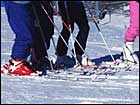|
Getting the gear
|
 |
December 13, 2001: 12:18 p.m. ET
The basics of buying ski and snowboarding equipment.
By Sarah Max
|
NEW YORK (CNN/Money) - We won't lie to you. The freedom of carving perfect turns down a velvety blanket of snow doesn't come cheap. If the $55 lift tickets, $200 hotel and $2 hot chocolate aren't enough to keep you on level ground, the price of equipment just might. Last year, skiers spent an average of $650 on skis, boots, bindings and poles, while snowboarders paid about $485 to gear up.
The good news is that ski vacation deals should be as abundant as Rocky Mountain snow this year. And unlike a lot of other big-ticket purchases, ski and boarding equipment has a pretty long lifespan. That's assuming you buy the right stuff in the first place.
Weigh the benefits of renting and buying
Before you spend a fortune outfitting yourself with all the newest gear, make sure you'll get on the mountain enough to get your money's worth. If you ski or ride less than five times a year, consider spending money on a good pair of boots and renting the rest. You can rent basic equipment for about $25 a day and "demo" high-end gear for around $35 a day. Many resorts replace their rentals almost annually, which means you'll always be on newer equipment. And as an added bonus, you don't need to worry about transporting all of your gear every time you head to the mountains.
Because kids grow out of their equipment every year, there is no question that renting is better than buying. "It's impossible to get more than one season out of kid's boots," said Joe Cutts, who is an editor at Ski magazine and the father of twin girls. "They're too big one year, perfect at baseball season and too small the next year." If you take your kids to the slopes more than five times a year, leasing is a more economic and convenient option. For $125 to $150, you can keep your kids in the right gear all season. In many cases, you can even exchange equipment if they grow before the snow melts.
Skip the bargains and find advice
Once you make the decision to buy, you'll want to find a ski or boarding shop where you can be certain the people selling you equipment know what they're talking about. Unless you feel pretty confident in your ability to evaluate equipment, better to pay a little more for good advice now and bargain hunt down the road.
Shops on the mountain tend to be more expensive than those at sea level, but you can be pretty sure that salespeople close to the slopes eat, sleep and drink their sport. You don't have to rule out your neighborhood outfitter, but make sure the selection is broad and the service is up to speed. "There are some excellent city shops, but watch out for the big box stores where guy selling you skis today is moving onto patio furniture next month," said Cutts.
While it pays to get the right advice, the rule that you "get what you pay for" only goes so far with ski and boarding equipment. In fact, the most expensive equipment is typically designed for experts and can actually put beginners and intermediates at a disadvantage.
"If a salesperson points you to the newest, hottest thing coming in without asking you a lot of questions first, you're probably in the wrong place," said Rick Steinle, merchandise manager for Sun & Ski Sports stores.
To be sure, the most important factors for shopping for ski and board equipment are your ability, your preferred terrain and your size. "Work with the people in the shop and be honest about your ability," said Cutts. "Of course a shop would love to believe you're Hermann Maier and sell you the most expensive ski on the wall, but they shouldn't" 
|
|
|
|
|
|

|

